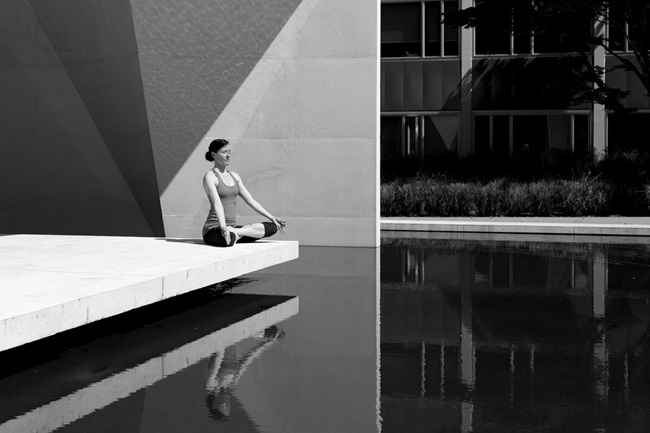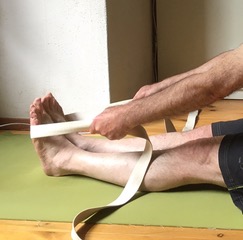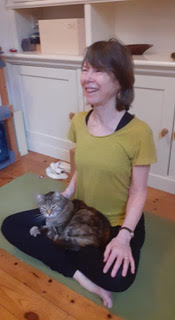
Some of you may have caught my ‘Yoga while you work’ session at last year’s Professional Development Day (PDD) and know that I’ve been teaching yoga for a while now. I’d like to share a little more of my experience, as well as some more information than would fit in the half-hour session we had that day.
 I came to yoga relatively late in life. After trying out several kinds of yoga (there is a bewildering array of them out there), I settled on Iyengar Yoga, named after Mr BKS Iyengar, one of a handful of people who brought yoga from India to the West in the second half of the 20th century. (He famously said, ‘Call it Iyengar yoga if you want to, I just call it “yoga”.’) In it, poses are generally held for longer and there is more focus on alignment than in most other forms. Iyengar also pioneered the use of ‘props’ such as blocks and belts, which help people feel the intention behind the poses. This is especially helpful for beginners.
I came to yoga relatively late in life. After trying out several kinds of yoga (there is a bewildering array of them out there), I settled on Iyengar Yoga, named after Mr BKS Iyengar, one of a handful of people who brought yoga from India to the West in the second half of the 20th century. (He famously said, ‘Call it Iyengar yoga if you want to, I just call it “yoga”.’) In it, poses are generally held for longer and there is more focus on alignment than in most other forms. Iyengar also pioneered the use of ‘props’ such as blocks and belts, which help people feel the intention behind the poses. This is especially helpful for beginners.
What is yoga?
Briefly, ‘yoga’ is a Sanskrit word meaning ‘union’, from which the English word ‘yoke’ is derived. Originally, yoga was pure meditation, practised to achieve union with the divine. Since devotees needed to be able to sit for hours at a stretch, a system of exercises was developed to strengthen and prepare the body for it. Today, there are many forms of yoga practised all over the world, ranging from pure meditation or service (e.g. working in an ashram) to athletic ‘flow’ and ‘power’ yoga.
Many schools of yoga, including Iyengar, draw inspiration from the ‘Yoga Sutras’, written by a sage named Patanjali sometime between 200 BCE and 200 CE. It begins more or less with the sentence ‘Yoga is the stilling of the fluctuations of the mind’. It goes on to describe how to do that, starting with precepts on how to act towards others and yourself, and on through breathing exercises, poses and meditation. Ultimately, one is freed from the encumbrances that the past and future can put on us; this is not done by ignoring them, but by recognizing when they’re in the way – then we can let go of them.
Because most yoga practised in the West focuses on the physical, most people seem to think it’s reserved for the bendy. (If I had a nickel for every time I’d heard ‘I could never do yoga, I’m too stiff!’…) In fact, yoga gets rid of stiffness. It can also make you stronger and the breathing, as well as poses like twists, allows better circulation to your abdominal organs.
I experienced all of the above benefits doing yoga. In learning to respect and acknowledge my boundaries, I also learnt that some of them could be stretched. While accepting other limitations, I also came to appreciate what our bodies do for us every day, in addition to transporting our brains to conferences, as someone once said. And – quite unexpectedly – I started to feel much calmer after a good session (I tend to be a little high-strung) and, occasionally, I can find that calm at off-the-mat moments as well. I’m not saying I’ve attained enlightenment by any means, but for me yoga really did and does ‘still the fluctuations’ of my mind.
If you feel that yoga is out of reach for you because of all the slick photos of people tied in knots in studio ads and Instagram posts, I’d like to say that the photo is a guide. Many people enjoy yoga without ever getting into the ‘final’ version of a pose. The beauty of yoga is that, unlike say, tennis, any effort towards that pose that entails some challenge for you is yoga. There are classes done sitting on/in chairs, even in wheelchairs. With a good teacher encouraging us, focusing awareness on the body compels us to stay in the present moment. Should that sound too ‘Land of Woo’, be assured that it’s very concrete. In fact it means that for an hour or so, we don’t get caught up in fantasizing about the future (e.g. to-do lists) or ruminating about the past (e.g. ‘that’s what I should’ve said…’), and it feels refreshing.
Yoga practice affects my work in that the body awareness helps me realize I’m sitting badly or need a break, before something starts to hurt. I also sometimes become aware of the old fluctuations acting up and decide it’s time to clear my head, or I notice I’ve been holding my breath for some indeterminate period.
I was so in spired by what yoga did for me that I eventually decided to teach (photograph on the left: during one of the lighter moments of the pandemic, teaching online). It wasn’t until I was teaching yoga that I realized what a good complement it is to my desk job. Not only does it get me out and get me moving, but I also have contact with other people, in person. (We got through Covid by going online and we got creative with using furniture, doors, books and many other objects as our props.)
spired by what yoga did for me that I eventually decided to teach (photograph on the left: during one of the lighter moments of the pandemic, teaching online). It wasn’t until I was teaching yoga that I realized what a good complement it is to my desk job. Not only does it get me out and get me moving, but I also have contact with other people, in person. (We got through Covid by going online and we got creative with using furniture, doors, books and many other objects as our props.)
Work comes into yoga when I realize how important language can be in teaching and that, for some people, words are not as good as visual cues or hands-on adjustments.
Once I started teaching, I felt a clear parallel with the idea of keeping your target reader in mind. As Stephen Johnson put it at the same PDD in his ‘How to write great copy’ workshop, the first question many of us ask when taking on a job is ‘who is going to be reading this?’. In my first teacher training, we practised teaching each other. There were twenty of us, relatively fit and young, and the yoga style was Vinyasa, the flowy kind. When I started to teach my own classes, I quickly realized that many of my students were older, stiffer and were dealing with some injury, and some students were male, and they simply couldn’t do all I was asking. Nothing makes someone abandon a class quicker than the feeling they’ll never get it. I had to tone it down for my ‘audience’ and think about what I could do to enable students to get the most out of the poses. The Iyengar training was much better in this respect. Starting from what the student can already do is more challenging than just reciting instructions and hoping people can imitate you, but it makes them feel good instead of inadequate and the connection makes it much more rewarding for both parties. I’m much more present myself because I’m observing them.
For me, yoga is a wonderful complement to my sedentary life as a translator and editor, and teaching is an antidote to the solitude. One last benefit: I don’t believe yoga will keep me young, but I do believe it’s helping me stay healthy as I get older. If you’re curious, look around – most teachers/studios offer a free or cheap trial class and many offer a short introductory course for beginners. I’m sure there is a form you’ll enjoy.
|
Blog post by: Anne Hodgkinson Website: www.rosettastonetranslations.nl/ Blog: www.bootsandbowtie.com/ |
